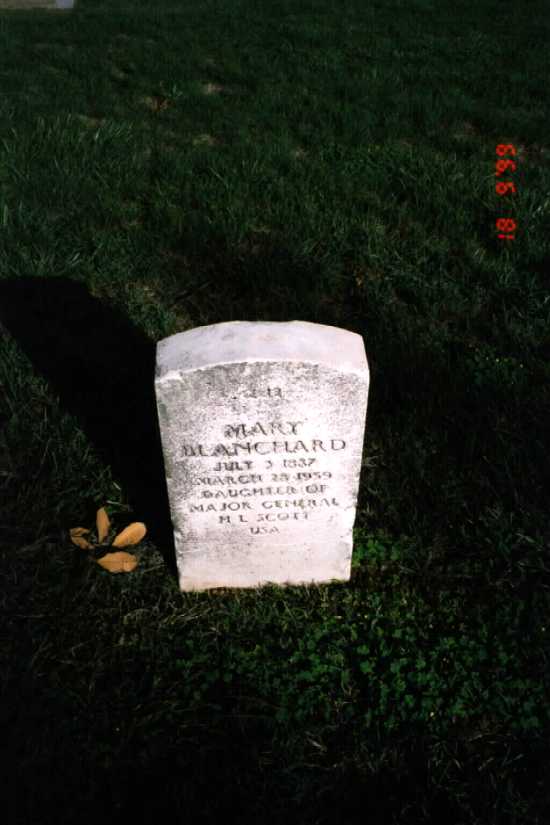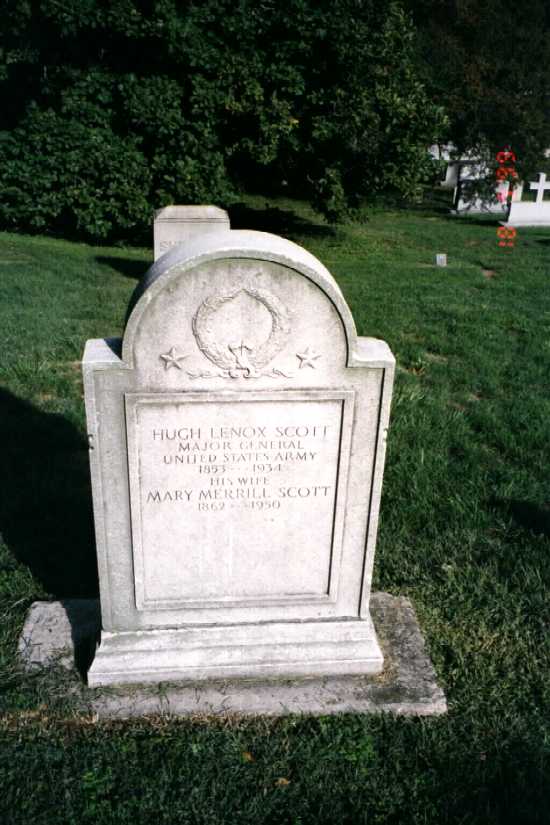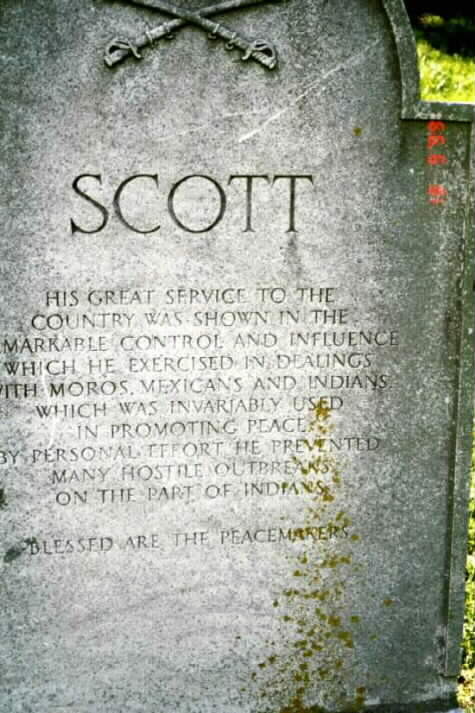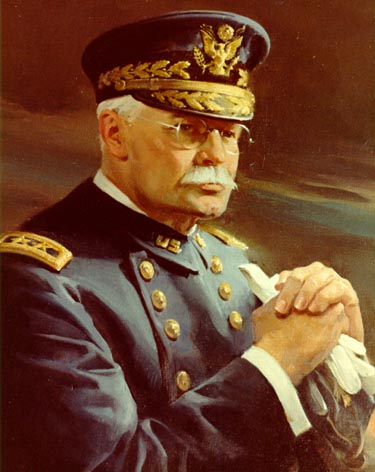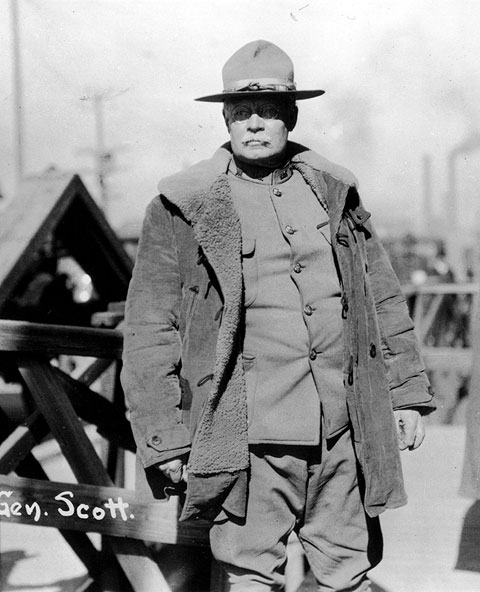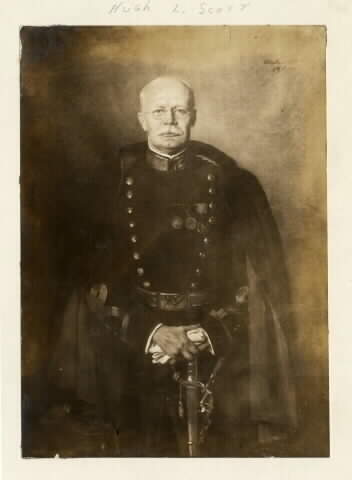Born September 22, 1853 in Danville, Kentucky, he grew up there and in Princeton, New Jersey. He graduated from West Point in 1876 and was commissioned in the Cavalry. For some twenty years thereafter he served on the Western frontier, chiefly with the 7th United States Cavalry. He saw action in campaigns against the Sioux, Nex Perce, Cheyenne and other Indians of the Plains and became an expert in their languages and ways of life. He was promoted to First Lieutenant in June 1878.
In 1890-91 he was given the responsibility for suppressing the “Ghost Dance” religious mania that swept the Indian Reservations and received official commendation for that work. In 1892, he organized Troop L of the 7th Cavalry, composed of Kiowa, Comanche and Apache Indians, and commanded it until it was mustered out, the last Indian Troop in the United States Army, in 1897. In 1894-97, he had charge of Geronimo’s band of Chiricahua Apache Indian prisoners at Fort Sill, Oklahoma. He was advanced to Captain in January 1895.
In November 1897 he was attached to the Bureau of American Ethnology of the Smithsonian Institution, where be began preparing a work on Indian sign languages. In May 1898, after the outbreak of the Spanish-American War, he was appointed Major of Volunteers and Assistant Adjutant General of the 2nd and 3rd Divisions, I Corps. He saw no action in that war, but in March 1899 went to Cuba as Adjutant General, Department of Havana, with the rank of Lieutenant Colonel of Volunteers. In May 1900 he moved up to Adjutant General of the Department of Cuba and remained in that post until May 1902. During that time he served for a time as Acting Governor and took an active part in the transfer of government into Cuban hands. He was promoted to Major of Regulars in February 1903 and served as Military Governor of the Sulu Archipelago, Philippines, in 1903-06 and also commanded troops there, taking part in various skirmishes, reorganized the civil government and institutions.
In August 1906 he was named Superintendent of West Point, a post he held for four years with the temporary rank of Colonel. He was promoted to regular Lieutenant Colonel in March 1911 and Colonel in August. He then commanded the 3rd U.S. Cavalry in Texas, engaged in settling various Indian troubles. In March 1913 he was promoted to Brigadier General in command of the 2nd Cavalry Brigade, still posted to the Southwest. He won special commendation for his skillful handling of Navajo disturbances at Beautiful Mountain, Arizona, in November 1913. He was named Assistant Chief of Staff in April 1914 and Chief of Staff of the Army in November and was promoted to Major General in April 1915. He continued to act in a diplomatic role with Indians and Mexican Border officials in the Southwest, settling problems with the Piutes of Utah in March 1915 and recoverying property “confiscated” by Pancho Villa in August.
In February-March 1916, he served as Ad-Interim Secretary of War. But his energy was directed more toward preparation for possible U.S. entry into World War I, and he was very influential in winning early acceptance among civil officials of the notion of conscription. He retired at the statuary age in September 1917 but remained on active duty. He became commander of the 78th Division at Camp Dix, New Jersey, in December and of Camp Dix again in March 1918. He retired finally in May 1919 and served on the Board of Indian Commissioners from 1919 to 1929 and was Chairman of the New Jersey State Highway Commission from 1923 to 1933. In 1928 he published an autobiography, “Some Memories of A Soldier.”
He died at Washington, D.C. on April 30, 1934 and was buried among many other family members in Section 2 of Arlington National Cemetery beneath a private memorial which reads:
“His great service to the country was shown in the remarkable control and influence which he exercises in dealings with the Moros, Mexicans and Indians, which invariably he used in promoting peace. By personal effort he preserved many hostile outbreaks on the part of the Indians.
Blessed are the peacemakers.”
SCOTT, HUGH L
MAJ GEN USA KY BATT
- DATE OF DEATH: 04/30/1934
- BURIED AT: SECTION EAST SITE S-12
ARLINGTON NATIONAL CEMETERY
Michael Robert Patterson was born in Arlington and is the son of a former officer of the US Army. So it was no wonder that sooner or later his interests drew him to American history and especially to American military history. Many of his articles can be found on renowned portals like the New York Times, Washingtonpost or Wikipedia.
Reviewed by: Michael Howard

